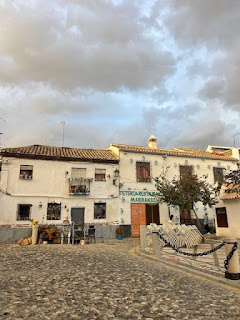The Alhambra definitely lives up to its billing as one of the most remarkable structures in the world. The greatest--and last--Moorish palace provides a window into the eight centuries when the Moors ruled Andalusia. Above, the Grand Hall of the Ambassadors. The wooden ceiling is crafted from more than 8,000 inlaid pieces.
Detailed ceiling murals provide a glimpse of life during Moorish rule. Note that Islamic doctrine, while not permitting the portrayal of icons, does allow the depiction of secular figures.
The Courtyard of the Lions
The Hall of the Abencerrajes, the sultan's living room. The ornate design is based on the eight sides of the Muslim star.
Washington Irving worked on Tales of the Alhambra while living in this room in 1829.
The view over the old Moorish town, the Albayzin.
The elaborate Gereralife gardens are a tranquil oasis.
The streets of Granada are lively and beautiful architecture is everywhere.
The renaissance Cathedral and Royal Chapel do not, unfortunately, allow photographs. The Cathedral is the second-largest in Spain (after Seville's) and the Royal Chapel houses the remains of Queen Isabel and King Ferdinand. It was during their reign that the reconquest of Andalusia from the Moors finally succeeded, with the surrender of the Alhambra, and they chose Granada as their final resting place.
The old Moorish quarter of Albayzin is a delight to wander; many of the streets are too narrow for vehicular traffic.
A communal water fountain.
The St. Nicolas viewpoint offers dramatic views of the Alhambra.
The Sacromonte District is the home of Granada's thriving Roma community. It is a very compact, steep, area with only one main street. Caves which have housed Roma for generations are now equipped with electricity and water. While several continue as residential properties, many are now restaurants and tourist stops. Some offer zambra shows, the local variant of the flamenco.









































No comments:
Post a Comment